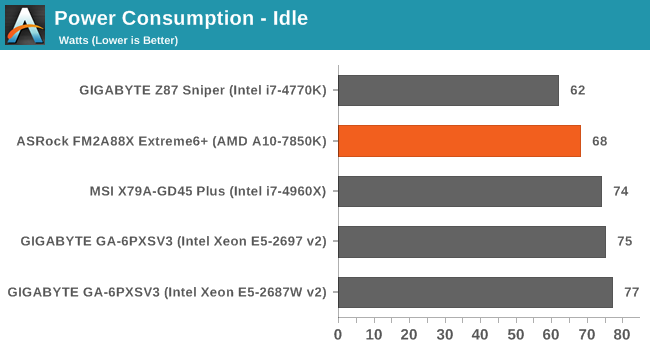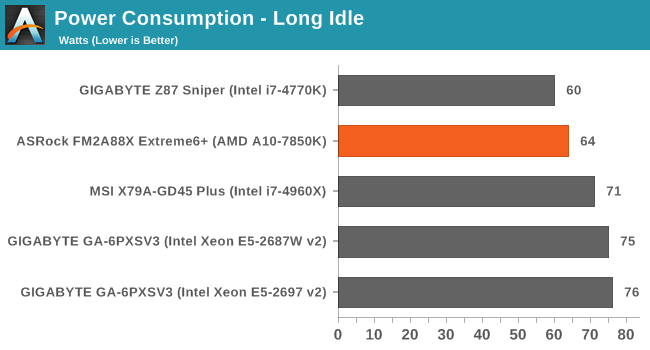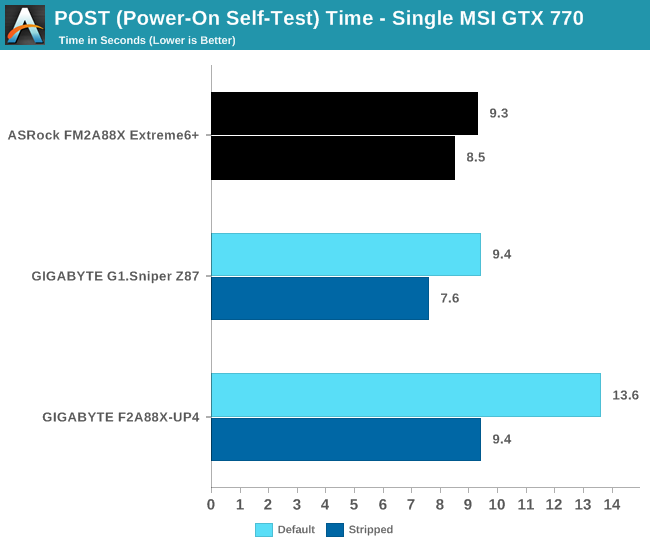ASRock FM2A88X Extreme6+ Review
by Ian Cutress on March 19, 2014 11:59 AM ESTMany thanks to...
We must thank the following companies for kindly providing hardware for our test bed:
Thank you to OCZ for providing us with 1250W Gold Power Supplies and SSDs.
Thank you to G.Skill and ADATA for providing us with memory kits.
Thank you to Corsair for providing us with an AX1200i PSU, Corsair H80i CLC and 16GB 2400C10 memory.
Thank you to ASUS for providing us with the AMD HD7970 GPUs and some IO Testing kit.
Thank you to MSI for providing us with the NVIDIA GTX 770 Lightning GPUs.
Thank you to Rosewill for providing us with the 500W Platinum Power Supply for mITX testing, BlackHawk Ultra, and 1600W Hercules PSU for extreme dual CPU + quad GPU testing, and RK-9100 keyboards.
Thank you to ASRock for providing us with the 802.11ac wireless router for testing.
| Test Setup | |
| Processor |
AMD A10-7850K (ES) 2 Modules, 4 Threads 3700 MHz, 4000 MHz Turbo 4MB L2 Cache |
| Motherboards | ASRock FM2A88X Extreme6+ |
| Cooling |
Corsair H80i Thermalright TRUE Copper |
| Power Supply |
OCZ 1250W Gold ZX Series Corsair AX1200i Platinum PSU |
| Memory | AMD Gaming 2x8GB DDR3-2133 10-11-11 Kit |
| Memory Settings | XMP |
| Video Cards |
MSI GTX 770 Lightning 2GB (1150/1202 Boost) ASUS HD7970 3GB (Reference) |
| Video Drivers |
Catalyst 13.12 NVIDIA Drivers 332.21 |
| Hard Drive | OCZ Vertex 3 256GB |
| Optical Drive | LG GH22NS50 |
| Case | Open Test Bed |
| Operating System | Windows 7 64-bit SP1 |
| USB 2/3 Testing | OCZ Vertex 3 240GB with SATA->USB Adaptor |
| WiFi Testing | D-Link DIR-865L 802.11ac Dual Band Router |
Power Consumption
Power consumption was tested on the system as a whole with a wall meter connected to the OCZ 1250W power supply, while in a single MSI GTX 770 Lightning GPU configuration. This power supply is Gold rated, and as I am in the UK on a 230-240 V supply, leads to ~75% efficiency > 50W, and 90%+ efficiency at 250W, which is suitable for both idle and multi-GPU loading. This method of power reading allows us to compare the power management of the UEFI and the board to supply components with power under load, and includes typical PSU losses due to efficiency. These are the real world values that consumers may expect from a typical system (minus the monitor) using this motherboard.
While this method for power measurement may not be ideal, and you feel these numbers are not representative due to the high wattage power supply being used (we use the same PSU to remain consistent over a series of reviews, and the fact that some boards on our test bed get tested with three or four high powered GPUs), the important point to take away is the relationship between the numbers. These boards are all under the same conditions, and thus the differences between them should be easy to spot.



Windows 7 POST Time
Different motherboards have different POST sequences before an operating system is initialized. A lot of this is dependent on the board itself, and POST boot time is determined by the controllers on board (and the sequence of how those extras are organized). As part of our testing, we are now going to look at the POST Boot Time - this is the time from pressing the ON button on the computer to when Windows 7 starts loading. (We discount Windows loading as it is highly variable given Windows specific features.) These results are subject to human error, so please allow +/- 1 second in these results.

ASRock have historically been good with POST times, and under 10 seconds is a good score.










44 Comments
View All Comments
fteoath64 - Friday, March 21, 2014 - link
AMD/ATI needs to be very aggressive in lowering the power demands of their gpu. What NV has done in Maxwell should tell them a very important thing. Lowering the power demands means, one can cram more cores into the die, hence it will boost performance. There is so much one can cram into a specific node-technology but the power demands meaning heat dissipation is going to be a real issue that is hard to solve.With the latest R9 series running at such high heat and high power demands, it is going to impossible to cram even half that performance into an APU without resorting to water cooling so the challenge is huge for AMD to tackle. I hope they can make headway into power optimization so that we can get more serious APU chips with powerful gpus for once and help move the industry along.
Ammohunt - Thursday, March 20, 2014 - link
cpu performance is one thing getting a stable glitch free windows system has always been the true challenge. I had never seen a Win7 BSOD until i ran an FX-6100 AMD Build which i promptly replaced with an intel rig. As a server it runs linux like a champ though.Demiurge - Friday, March 21, 2014 - link
I have multiple laptops, all Intel based, at work that BSOD Win7. It isn't the CPU, it's the drivers. I know because mine doesn't crash anymore after updating the drivers. I'm pretty sure it isn't the CPU that was the weak point of failure in most problems because the CPU is one of the few things that gets tested and validated the most. Not saying it can't happen, but it is far more likely you or the device manufacturers screwed up. Trust me, I own a Creative X-Fi =)... sometimes I don't get sound on reboot. I know the hardware's good there too.MrBungle123 - Friday, March 21, 2014 - link
I've noticed instability with AMD rigs before and discovered that the issue was that the stock voltage was too low. AMD is always trying to compete from a process node behind so I think they drive the Vcore as low as possible to try and bring down their TDP numbers and as a consequence bring the CPUs to the edge of instability.0ldman79 - Saturday, March 29, 2014 - link
Odd.I've found that most of my AMD chips can work fine with a little less voltage at stock speeds.
Of course they don't stay that way, the tech in me overclocks them and gets Cool'n'Quiet working so they idle nice and cool then ramp up when needed.
Demiurge - Friday, March 21, 2014 - link
Not sure why...I see something a little different...Tomb Raider is probably very heavily AMD CPU (just assuming relative to the other benchmark performance) optimized because the $200 APU + GTX 770 is actually outperforming (ever so slightly) the $1000 and $320 I7... In the F1 game the exact opposite is happening ~84fps vs ~129fps... from what I see in the other games, it looks like about a -15% typical difference toward the APU just by looking at a high level. That's not bad considering the price/performance ratio.
The numbers (to me) aren't important as a CPU comparison for the vague remarks I made about suspected optimization, but it does matter if you are comparing the game performance in order to make a decision about which CPU to buy if I play a particular set of games.
PUGSRULE! - Monday, August 10, 2015 - link
As of today 8-10-15 an Intel i7-4960X costs $1,100 versus an AMD A10-7850k that goes for $130. If you have an unlimited budget, yeah go for the Intel. But dollarwise, you cannot do better with the AMD. It's like comparing a Hennessey Venom GT to a Mustang.TETRONG - Wednesday, March 19, 2014 - link
Hmm, I agree. It's confusing why they keep reviewing and devoting so much time to something that hasn't been viable for a long time. Anyone can compare performance/price and conclude that there is no good AMD buy relative to Intels Core/Xeon lineup. It doesn't sound so bad until you factor in electricity which completely negates anything AMD might otherwise have going for them. Whatever you would save with the cheaper chip would get eaten up by the utilities -No thanks
tech6 - Wednesday, March 19, 2014 - link
I think they can be viable at a certain price point. Offering "good enough" performance for office and non-3D gaming computers is AMDs strength and that is where OEMs should be aiming also. Making a $100+ "Extreme" AMD board makes no performance sense at all.bobbozzo - Wednesday, March 19, 2014 - link
A mini-ITX Kaveri is attractive for HTPC builds, thanks to the excellent integrated graphics.